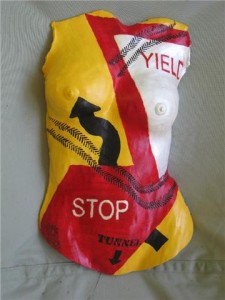
When you take a class, is the finished product yours? Even if you worked the product from a project sheet, the teacher helped and everyone wound up with something that looks a bit alike?
I’d never even thought of this question before yesterday! I assumed that work I make, no matter how, is my work and I can price it and sell it where, when and how I please.
For instance, the bracelet pictured here is from a class I took to learn techniques for changing pieces of metal into wearable jewelry. We all turned out something like this. Our teacher had learned the technique in a class she traveled to take. Who knows where of if her teacher was self-taught. The style, as reflected in the name, originated in the Punk culture. To my mind, that makes it all derivative of the original Punk impulse.
To my mind all art is derivative.
If I don’t take a class, but gather photographs

from magazines or picture books or other art, does that make me a thief? Many of the paintings I did in the 90s were collages of images I gathered and then put together in my own order.

When I teach students how to make torsos, my own high end line, I put no caveats around it. I teach them the technique and the final piece is entirely theirs to do with as they wish. In fact, one student from an earlier class in making Ugly Fish took the idea out and created her own line of fish. To my way of thinking, this is part of the reason one takes a class.And the exchange is even, because I always learn from my students and am inspired by their creativity and take on what I’m teaching.This whole topic garnered lively discussion on my FaceBook yesterday (find me on Facebook by clicking the pink “f” to the right here, under my photo, and go to my profile page where you should be able to pick up the discussion). Everyone who replied publically supported the creator’s right to her creation no matter how it happened. One private response, very thoughtfully done, said this:
I had never given any thought to this at all before an artist friend of mine asked me what percentage of a creation has to be “original” (quotes mine) before she could price and sell her work. I have greatly enjoyed the discussion – including the above which I think is a needed part of the entirety. We all bring our own experiences to the table. Sharing is good!
Hope you will leave some thoughts of yours here to further the discussion! All of it has certainly broadened my horizons.
Wylde Women’s Wisdom
This is your life. You are responsible for it. You will not live forever. don’t wait. Make the time now…. Natalie Goldberg
This having been said, all of us need to learn a new art or skill by basing it on the work of others, because this is how we learn.
In this case, it is fine to make someone else’s design, just give the designer credit. “beaded from / based on a design made by XX.” If we do this, we not only protect the intellectual property of the original artist, but we share the credit for the beautiful work that we’ve just made. This creates a very positive environment for our own art work. The linkage to another artist further enhances the value of our work because we can demonstrate the benefit of the training we received.



20 Comments
a must for the conversation: “Steal Like an Artist”
http://www.austinkleon.com/2011/03/30/how-to-steal-like-an-artist-and-9-other-things-nobody-told-me/?utm_source=feedburner&utm_medium=feed&utm_campaign=Feed%3A+austinkleon+(AUSTINKLEON.COM)
You have really set the cat among the pigeons haven’t you ;0)
I have seen many classes and the results. For example Tim Holtz recently had done some work shops provided all the elements to make an item and then people have done their own thing. Is that their own? I hope so or every thing I make with some one else’s stamps paints products isn’t mine is it?
I know what you mean, I have seen some thing in a magazine that I adored and I made my own I gave credit for the original inspiration or I wouldn’t of been able to make that one thing with out them as a starting point.
When you talk about giving a technique away and some one sells items including that technique that’s not sealing in my mind. However, if you made a fish model and I thought I can see a market for these at my local craft fair and make a ton of them all in different colours etc that has to be stealing doesn’t it? (making money off some one else’s idea) I thought that’s what copyright was all about but in the artist world is there such a thing? I am sure people who paint the mona lisa and sell it as their own can’t do so (but they can if they use different paints and size so it can’t be passed off as the real one)
There is lifting I know about that I have been asked and that’s fine where maybe some one sees a card I have made and use the same lay out as I have but surely this is their card just inspired by mine (not stealing)
On looking at all the comments it becomes quite confusing but I think if you change 90% of an original then that should be yours. I am still not sure about classes that provide all the elements to make something being yours although I think Tim would say yes this is your own project other wise why would you go and gain this experience buy all his goods make some thing out of his (alteration boxes I am mainly thinking of here) every ones is going to look similar but surely they are all individual pieces of art, it’s like we all get the same size lamp shade and I am sure each one would be a complete original wouldn’t it?
Well that’s my thoughts and no I am not a thief ;0)
Interesting article – I don’t know her work but I do know this: once you start teaching and publishing your techniques are being offered to the public in general. If you don’t like the results, then don’t teach or publish.
I read this recently and found it very interesting – she is quite specific…
http://kellyraeroberts.blogspot.com/2009/03/what-is-and-is-not-okay.html
Life is like that isn’t it – leaving it up to us to make the final choice! I say follow your heart!
So glad to find this discussion. This subject has been such a source of confusion for me, too. I recently created an art piece following the diagrams, photos and instructions in an art/craft magazine. I donated the piece to a cancer fundraising event for their silent auction, the whole time wondering if I had the right to sign my name to it. Still not 100% sure. Wish there were some definitive answers to this problem.
Thanks for your input Ladies….not sure if that’s Picasso, but I’ve heard it before and know from my art history that it’s a definite fact!
An artist I modeled for back in the young years leaves open space in her compositions so “your eye can finish”…seems to me that we not only have collective consciences from which images and ideas spring, but then there’s those 600 images a day we are all exposed to…wasn’t it Picasso who said good artists borrow and great artists steal?
If you learn a design from a teacher it is theirs unless you change it significantly. Some people insist their techniques are sacred too. I agree there is nothing new. No one should copy outright or just change colors and call that enough change. Someone mentioned Warhol and the Campbell’s soupcan. Didn’t he realize there was a copyright on the design of the can? Yet no one seems to ming that he painted it and sold the painting. Are we just getting very “protectionist” today? Everyone seems to worry they’ll lose their little slice of the money pie or the fame pie rather than caring about sharing the art and having enough pie for everyone. We are living in fear rather than abundance as a norm anymore and it is really sad.
Thank you for bringing this topic up for discussion, Tammy. When I start a new project, this is one of the parts that I grapple with. I am driven to be original. Not that I wouldn’t use techniques or ideas that I may have seen somewhere else, but that these have emerged from my subconscious mind and melded or morphed somehow into something that I can call intuitive.
Art is like cooking. You may use this fabulous dessert recipe for your grandmother, the taste of yours will always be different … not better or worse, different.
I think any activity that relates to human expressions changes, evolves, grows, it is alive as we are.
The great thing is that we can share an learn form each other.
The rest of the ideas related to marketing, are about ethics and in the bottom of our hearts we know when something is not ours.
Muy interesante el debate, gracias Tammy.
Carol
I so agree with this, and I’ve always thought the energy we bring to a piece is different so the piece will be different too. But recently an artisan friend had someone copy her beadwork bead for bead and claim it as her own. Discouraging – and yet, the person did the work if not the design. So the question is definitely out there, and I’m wondering if it’s something people always address at classes. I never even thought about it before I was asked!
Make it your own-simple. Any workshop I’ve attended where technique or process is taught everyone’s final product is different-similar maybe but different! Andy Warhol was inspired by a Campbells soup can-he painted it-himself-he didn’t try to sell the actual can or label! Be inspired and acknowledge inspiration-don’t reproduce-make it your own!
I think to use or copy someone’s creations and then sell them as “your own” is wrong. To incorporate a technique or some collage material into an artwork that you have completed and “made your own” is fine. We do progress… I do think though, that if you see something online, for example, and go on to use a very similar style or method to then sell your own art, the least you could do is refer to the original and say it was “inspired by”… thus giving credit to the person who inspired you!
No matter how original we think we are, there is nothing original in art really – it’s all been done before or is a variation on a theme. You only have to look at Fashion to see the same styles returning decade after decade!!
Thanks, Elizabeth!
We have a group of folks in my area who hang out – and I know we all influence each other
as well as give each other ideas. I have taught and had my ideas taken for sale – I just see that as an extension of what I’m teaching. I always feel as if I’m a conduit anyways, and so the energy is free to flow through someone else too! (and it will be different – if only
by a feeling).
Having been trained as an academic reference librarian it is generally the view in copyright law that you can use approximately 10% from the original without it being considered an infringement. That having been said however, my thoughts are in line with yours Tammy, all art is progressional, if you will. We get ideas from each other and tweak and twist it with the addition of our own interpretations. There are very few completely original ideas in life – fact. I tend to approach my art as an extension of this idea, I believe in the angel policy so long as my work is not just a complete knock off nor mass produced for profit. I have no problem with being a part of the larger cosmos of evolution in the art process. We all learn from one another and I believe that is how it should be. One woman’s opinion.
thanks so much for sharing your thoughts on this subject – well said!
Like Debbie, some teachers are very hands-on. I AVOID teachers like that, because I want to create my own art.
That said, I have been in a classroom setting that was more like a shared studio space than a class. The instructor only provided guidance upon request and was available only during the class time. The creations from that class are purely mine, with his guidance taken or not. Yes, I consider the art from this type of setting as mine with rights to sell.
However, a class that is more like a “paint by numbers” would be considered the instructor’s art. I would be within my rights to use a similar idea at a later time, but would definitely need to make it extremely different so it is “mine.”
This brings to mind a class I took of techniques that can be found in many books, videos, etc., but were taught in a workshop. The art is mine because the techniques are not copywriter to one person.
Now, if at any time the instructor gets their hand into my work, I don’t consider it mine any more…and feel uneasy to sell.
Don’t know if there is a clear answer to this….
I think I am more concerned with a piece of art that began in a classroom with the instruction giving a handout with another artist’s photo of the finished product. In some cases, there have been step by step directions and even some with the color to use. If that is the finished product but changed by using different colors, placing a building elsewhere or removing objects – can this then be called one’s own finished painting?
I agree with everyone for the most part. With one exception. I have taken classes where the teacher is very hands on and does a lot or most of the work themselves. If that is the case, I would not feel comfortable with signing that particular work and selling it. I do however save it as a reference. I don’t particularly like this type of teaching because I learn more by doing it myself.